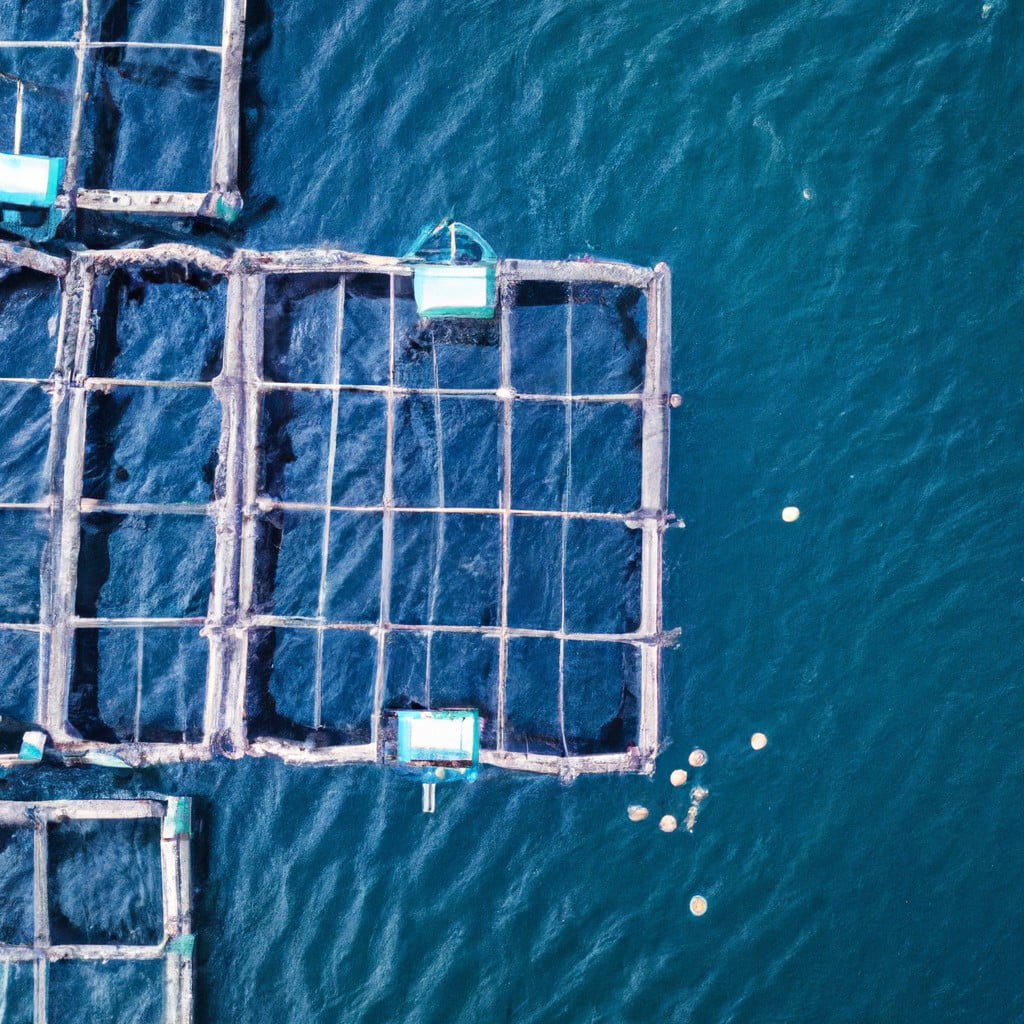Regenerative ocean farming is a sustainable agricultural practice that leverages the unique ecosystem of our oceans to cultivate seafood and marine vegetation while simultaneously revitalizing marine life and ecosystems.
Regenerative ocean farming is an innovative approach to aquaculture that aims to restore ocean ecosystems while simultaneously providing sustainable food sources. This method involves growing a variety of sea crops and raising marine animals such as shellfish and seaweed in vertically stacked layers.
These species naturally filter nutrients and carbon dioxide from the water, improving ocean health and combating climate change. Moreover, regenerative ocean farming requires no fresh water, no deforestation, and no fertilizer, making it a highly sustainable form of agriculture.
This article delves deeper into the techniques, benefits, and implications of regenerative ocean farming, providing a comprehensive understanding of this revolutionary practice.
Key takeaways:
- Regenerative ocean farming is a sustainable agricultural practice.
- It involves growing sea crops and raising marine animals.
- It improves ocean health and combats climate change.
- It provides diverse products and economic opportunities.
- It promotes marine biodiversity and enhances ecosystems.
Look Inside:
Definition of Regenerative Ocean Farming

Regenerative ocean farming is a form of aquaculture designed to mimic nature and promote biodiversity. It involves growing underwater crops – particularly various species of seaweed, along with shellfish like oysters, mussels, and scallops – in a vertically-integrated fashion.
This use of the complete water column fosters a marine permaculture that enhances productivity and sustainability. Unlike traditional farming methods, it demands no added inputs such as feed or freshwater, making it a low-impact, high-efficiency food production system.
The system’s design allows it to yield a diversity of products for a spectrum of uses, from human food to feed for animals, and from fertilizer for crops to biofuel feedstocks.
How Regenerative Ocean Farming Works
Seaweed and shellfish are at the core of this sustainable farming approach. With the use of simple, low-cost gear and minimal footprint, farmers suspend ropes under the water’s surface, creating vertical columns for seaweed to grow and shellfish to breed.
Seaweed, being an exceptionally fast-growing plant, efficiently absorbs harmful excess nutrients and carbon dioxide from the water, thus mitigating harmful climate change effects. Simultaneously, shellfish filter and purify the surrounding water, enhancing its quality and benefiting the ecosystem at large.
In addition, much like a multi-layered garden, this vertical farming method allows for the cultivation of various other sea crops beneath the surface.
The Importance of Regenerative Ocean Farming
This sustainable method of marine agriculture is essential for several reasons. First, it mitigates climate change by absorbing and sequestering large quantities of carbon dioxide, a major greenhouse gas. Second, it doesn’t depend on added fertilizers or fresh water, making it an environmentally friendly solution. Third, it creates habitats for a variety of marine species, contributing to increased biodiversity effectively. Lastly, it ensures food security by diversifying our food sources and potentially providing a significant amount of the world’s dietary protein. Its multi-fold benefits make it not just a sustainable practice but a restorative one, having a positive, proactive impact on our ocean ecosystems.
Benefits of Regenerative Ocean Farming
Regenerative ocean farming has key environmental benefits. It helps combat climate change by capturing carbon and nitrogen. The grown species like seaweeds and shellfish actively clean the water by filtering excess nutrients, contributing to water quality improvement.
On a commercial level, this farming method offers a sustainable, healthy, and enhanced protein source. Seaweed, a major product of this farming, is highly nutritious, providing minerals, vitamins, and a vegan source of omega-3 fatty acids.
Moreover, small-scale farmers can benefit economically as well. This method requires minimal inputs, lowering the barriers to entry, and provides a consistent income through the sale of diverse marine species.
Finally, it promotes a more sustainable food system by decreasing reliance on land-based farming, which often has significant environmental impacts.
Impact On Marine Biodiversity
Regenerative ocean farming actively contributes to the flourishing of marine biodiversity. The farming structures and seaweed crops serve as habitats for a variety of marine species, fostering rich ecosystems that boost biodiversity.
Simultaneously, shellfish farmed in these systems filter and cleanse the water, improving conditions for surrounding marine life. In this way, not only does this form of farming not harm the local biodiversity but it actively enhances it.
Challenges in Regenerative Ocean Farming
While this farming practice holds immense promise, it also faces significant hurdles. Navigating the regulatory landscape primarily designed for traditional forms of aquaculture can hamper its scalability. Additionally, it requires substantial upfront investment, which may not be feasible for many small-scale farmers. The lack of infrastructure for processing and marketing sea crops is another challenge. Also, changes in ocean temperature and acidity due to climate change can affect the growth and survival of marine crops and animals. Lastly, there is often local resistance from coastal communities and industries who view these farms as competition for space and resources.
Future Potential of Regenerative Ocean Farming
The adoption of this practice could revolutionize the way seafood is produced. It opens the door to a shift from traditional, often harmful fishing methods to a more sustainable, environmentally-friendly approach that promotes biodiversity.
Exploring the untapped potential of the ocean’s organic produce provides a dependable source of income for coastal and fishing communities, which often bear the brunt of fluctuating fish stocks.
Furthermore, the extensive growth of seaweeds and shellfish sequesters substantial amounts of carbon and nitrogen, potentially playing a critical role in combating climate change.
Additionally, this practice doesn’t compete with land-based farming, expanding the global food production capacity without adding more pressure on terrestrial ecosystems.
Hence, vast opportunities exist for the development of a blue-green economy centered around regenerative ocean farming, representing a paradigm shift in our relationship with the sea.
FAQ
How does regenerative ocean farming work?
Regenerative ocean farming operates by cultivating a variety of species, each serving a crucial function, similar to the diverse ecosystem of an ocean reef, leading to the restoration and rejuvenation of the marine environment.
What are the benefits of regenerative ocean farming?
Regenerative ocean farming contributes to the reduction of nutrients that cause algal eutrophication, decreases the risk of marine dead zones, and enhances marine biodiversity.
How does ocean farming work?
Ocean farming works by cultivating seaweed and shellfish in compact underwater gardens, contributing to the regeneration of marine ecosystems.
What is the meaning of ocean farming?
Ocean farming, also known as aquaculture, is the practice of breeding, raising, and harvesting fish, shellfish, and aquatic plants, contributing to environmental responsibility, creating healthier habitats, and supporting the conservation of threatened or endangered species.
What distinguishes regenerative ocean farming from traditional aquaculture methods?
Regenerative ocean farming differentiates from traditional aquaculture by promoting biodiversity, enhancing marine ecosystems, and sequestering carbon, rather than focusing solely on high-yield monoculture production.
How can regenerative ocean farming support the mitigation of climate change?
Regenerative ocean farming can mitigate climate change by sequestering carbon and nitrogen, restoring marine ecosystems, and providing sustainable food sources.
How does regenerative ocean farming contribute to biodiversity in marine ecosystems?
Regenerative ocean farming enhances biodiversity by creating underwater habitats that support a diverse range of marine species.




